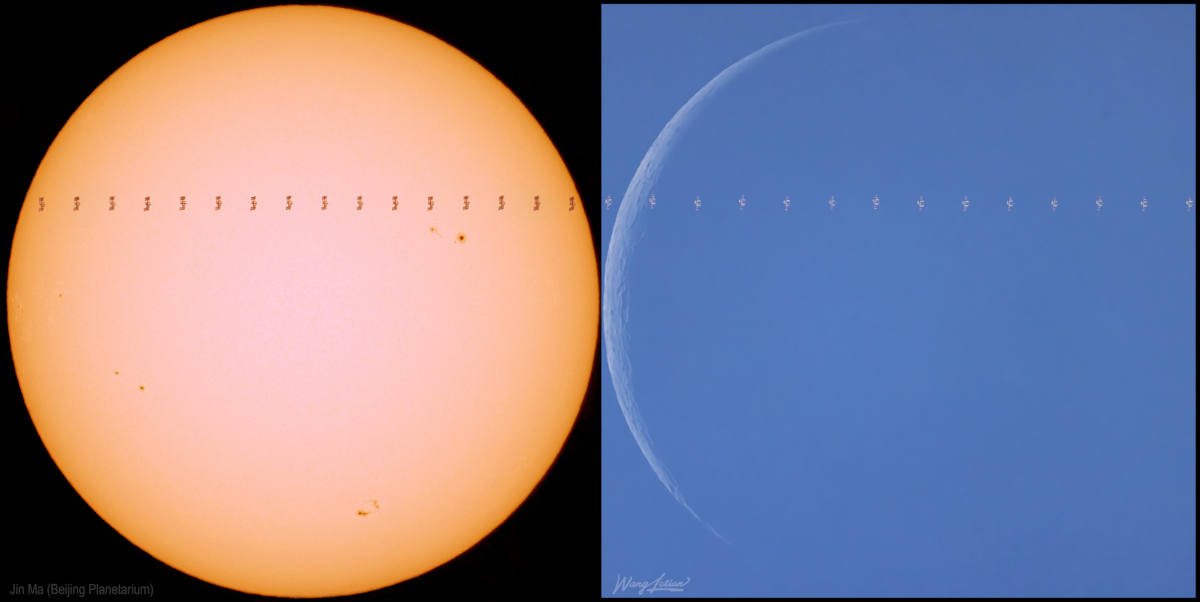03. September 2022
太陽, 月球, kah 國際太空站

探索宇宙1!逐工會揀一幅無仝款 ê 影像抑是相片,𤆬你熟似咱這个迷人 ê 宇宙,閣有專業天文學者2為你解說3。
- 原始文章:Sun and Moon and ISS
- 影像來源 kah 版權:Wang Letian (Eyes at Night), Jin Ma (Beijing Planetarium)
- NASA 火箭 Artemis I:欲發射 ê 上新消息
- 台文翻譯:An-Li Tsai (NCU)
[漢羅] 日頭, 月娘, kah 國際太空站
8 月 25 這工,咱日時會當 tī 天頂看著日頭 kah 月娘。 咱嘛仝款會看著 國際太空站 ISS。 Tī 中國北京順義區 中晝 11:02 ê 時陣,ISS ùi 月球面頭前飛過。 這陣 ê 月娘是下月眉。 另外 tī 順義區西南爿 40 公里遠 ê 豐臺區 嘛看著 ISS ùi 太陽盤面頭前飛過。 這个凌日 ê 過程才 29 秒鐘爾爾。 這幅圖 kā 凌日 kah 凌月 ê 相片囥做伙。 這兩張相片分別是 tī 彼兩个所在翕–ê。 是 kā 影片內底 ê 影格影像,疊疊咧、處理理咧,才組合做這幅圖。 欲協調翕出這兩張相片,愛用無仝設備,予太陽 kah 月球看起來平大。 這个 ISS ê 大細,ùi 凌月 現象算出來–ê,是 435 公里。 Ùi 凌日 現象算出來–ê,是 491 公里。
[POJ] Ji̍t-thâu, Goe̍h-niû, kah Kok-chè Thài-khong-chām
8 goe̍h 25 chit-kang, lán ji̍t-sî ē-tàng tī thiⁿ-téng khòaⁿ-tio̍h Ji̍t-thâu kah Goe̍h-niû. Lán mā kāng-khoán ē khòaⁿ-tio̍h Kok-chè Thài-khong-chām ISS. Tī Tiong-kok Pak-kiaⁿ Sūn-gī-khu tiong-tàu 11:02 ê sî-chūn, ISS ùi Goe̍h-kiû bīn-thâu-chêng poe kòe. Chit-chūn ê goe̍h-niû sī ē-goe̍h-bâi. Lēng-gōa tī Sūn-gī-khu sai-lâm-pêng 40 kong-lí hn̄g ê Hong-tâi-khu mā khòaⁿ-tio̍h ISS ùi Thài-iông-pôaⁿ bīn-thâu-chêng poe kòe. Chit-ê lêng-ji̍t ê kòe-têng chiah 29 bió-cheng niā-niā. Chit pak tô͘ kā lêng-ji̍t kah lêng-goe̍h ê siòng-phìⁿ khǹg chò-hóe. Chit nn̄g tiuⁿ siòng-phìⁿ hun-pia̍t sī tī hit nn̄g ê só͘-chāi hip–ê. Sī kā iáⁿ-phìⁿ lāi-té ê iáⁿ-keh iáⁿ-siōng, tha̍h-tha̍h leh, chhú-lí-lí leh, chiah cho͘-ha̍p chò chit pak tô͘. Beh hia̍p-tiau hip chhut chit nn̄g tiuⁿ siòng-phìⁿ, ài iōng bô-kâng siat-pī, hō͘ Thài-iông kah Goe̍h-kiû khòaⁿ–khí-lâi pîⁿ tōa. Chit-ê ISS ê tōa-sè, ùi lêng-goe̍h hiān-siōng sǹg–chhut-lâi–ê, sī 435 kong-lí. Ùi lêng-ji̍t hiān-siōng sǹg–chhut-lâi–ê, sī 491 kong-lí.
[KIP] Ji̍t-thâu, Gue̍h-niû, kah Kok-tsè Thài-khong-tsām
8 gue̍h 25 tsit-kang, lán ji̍t-sî ē-tàng tī thinn-tíng khuànn-tio̍h Ji̍t-thâu kah Gue̍h-niû. Lán mā kāng-khuán ē khuànn-tio̍h Kok-tsè Thài-khong-tsām ISS. Tī Tiong-kok Pak-kiann Sūn-gī-khu tiong-tàu 11:02 ê sî-tsūn, ISS uì Gue̍h-kiû bīn-thâu-tsîng pue kuè. Tsit-tsūn ê gue̍h-niû sī ē-gue̍h-bâi. Līng-guā tī Sūn-gī-khu sai-lâm-pîng 40 kong-lí hn̄g ê Hong-tâi-khu mā khuànn-tio̍h ISS uì Thài-iông-puânn bīn-thâu-tsîng pue kuè. Tsit-ê lîng-ji̍t ê kuè-tîng tsiah 29 bió-tsing niā-niā. Tsit pak tôo kā lîng-ji̍t kah lîng-gue̍h ê siòng-phìnn khǹg tsò-hué. Tsit nn̄g tiunn siòng-phìnn hun-pia̍t sī tī hit nn̄g ê sóo-tsāi hip–ê. Sī kā iánn-phìnn lāi-té ê iánn-keh iánn-siōng, tha̍h-tha̍h leh, tshú-lí-lí leh, tsiah tsoo-ha̍p tsò tsit pak tôo. Beh hia̍p-tiau hip tshut tsit nn̄g tiunn siòng-phìnn, ài iōng bô-kâng siat-pī, hōo Thài-iông kah Gue̍h-kiû khuànn–khí-lâi pînn tuā. Tsit-ê ISS ê tuā-sè, uì lîng-gue̍h hiān-siōng sǹg–tshut-lâi–ê, sī 435 kong-lí. Uì lîng-ji̍t hiān-siōng sǹg–tshut-lâi–ê, sī 491 kong-lí.
[English] Sun and Moon and ISS
On August 25 Sun and Moon could both be seen in planet Earth’s daytime skies. And so could the International Space Station. The ISS crossed the disk of the waning crescent Moon as seen from Shunyi district, Beijing, China at about 11:02 am local time. Some 40 kilometers to the southwest, in Fengtai district, the ISS was seen to cross the Sun’s disk too. The solar transit was observed only 29 seconds later. Both transits are compared in these panels, composed of processed and stacked video frames from the two locations. The coordinated captures were made with different equipment, but adjusted to show the Sun and Moon at the same scale. The ISS was at a calculated range of 435 kilometers for the lunar transit and 491 kilometers when passing in front of the Sun.
詞彙學習(漢羅/POJ/KIP/華語/English)
- 【國際太空站】Kok-chè Thài-khong-chām/Kok-tsè Thài-khong-tsām/國際太空站/International Space Station (ISS)
- 【下月眉】ē-goe̍h-bâi/ē-gue̍h-bâi/殘月/waning crescent Moon
- 【凌月】lêng-goe̍h/lîng-gue̍h/凌月/lunar transit
- 【凌日】lêng-ji̍t/lîng-ji̍t/凌日/solar transit